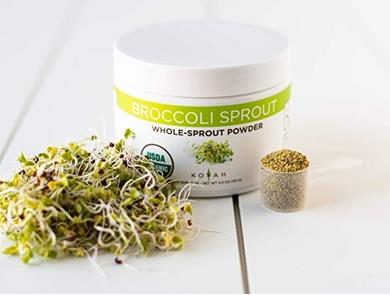I have read, re-read, and taken notes on Albert's and Recue's wonderful and lengthy lesson on broccoli seeds and sprouts healthunlocked.com/cure-par...
I can't say I understand everything, but I picked up the highlights (I think!) Capsules are weak! We need to convert the glucoraphanin to sulforaphane before we ingest it. We should add a second source of myrosinase that is more robust and more effective than that in broccoli. And to quote Albert "Concerning dosage. In the trial we got the best results at a remarkably low dosage. The range (in dry seed equivalent) was 0.6 to 1.2g per day. Calculated from the glucoraphanin content of the seeds, assuming a conversion yield of 70%, we get about 15 - 25 micro mol of sulforaphane."
So... is there an easy way I can make this happen for myself? And still keep the price well below the $3 a day of the Avmacol pills?
I stumbled across this Freeze-dried Organic Broccoli Sprout Powder ($45 for 36 servings) amazon.com/KOYAH-Freeze-dri...
- ACTIVE MYROSINASE - Freeze-dried raw to preserve active Myrosinase enzyme. Each batch is 3rd party tested to ensure the myrosinase is active.
- GLUCORAPHANIN (Sulforaphane Glucosinolate) - 3rd Party tested for Glucoraphanin content. Glucoraphanin turns into Sulforaphane when Myrosinase is present and water is added.
- USA GROWN - Sprouted and Freeze-dried in the USA. Certified Organic. Non-GMO.
- EACH JAR - 36 scoops. Each scoop of powder is equivalent to 1/4 cup of fresh organic broccoli sprouts.
- INGREDIENTS - Organic Freeze-dried Whole Broccoli Sprout Powder (includes the sprout and seed portion of the sprout). 100% Pure. No additives.
- Each jar (120 g of powder) = 9 cups of fresh organic broccoli sprouts (based on 1 cup of fresh broccoli sprouts being 40 g and having a 3:1 dry down ratio - meaning 40 g of raw sprouts freeze-dries down to 13.33 g of dry powder).
- Each scoop (3.4 g) = 1/4 cup of an organic broccoli sprouts (36 scoops per jar).
We test the product specifically for glucoraphanin (which is the precursor molecule to sulforaphane) and active myrosinase enzyme (which is what converts the glucoraphanin to sulforaphane). When the powder is rehydrated, the active myrosinase enzyme converts the glucoraphanin to sulforaphane.
Okay, so what if...
I put a scoop of this stuff into a mug with a half a scoop of ground white mustard, poured in some hot (but not too hot) water and let it steep for 5 minutes and sipped it slowly, sloshing it around my mouth as long as I could?
And maybe, given that a scoop is 3.4 grams and Albert's trial found 0.6 to 1.2g per day to be optimal, maybe I don't need a full scoop and can get more than 36 servings out of this jar? Maybe I can use half a scoop and get 72 servings? That would bring the cost down to well under a dollar a day.
I feel really lazy suggesting this method, but a man needs to embrace his limitations. I'm kind of lazy.
Would this work?


